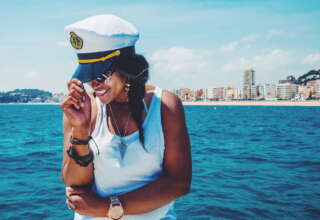
In 2004 businessman Malik Fernando bought Castlereagh, a decrepit bungalow in the terraced, emerald hills of Sri Lanka’s sprawling tea country. The structure had no roof. “It was in absolute shambles,” he recalls. “There were cattle roaming through the whole house.”
But it had one irresistible asset: “It was what was available,” he says, shrugging and welcoming me to the neat, gingerbread-style mansion on a clear, 80F winter day. That was enough to make it the perfect place for the area’s first luxury hotel.
When Fernando closed 13 years ago on Castlereagh, Sri Lanka’s government was in a cease-fire with a secessionist militia, the Liberation Tigers of Tamil Eelam, and optimism was in the air. He saw an opportunity to cater to fans of his family’s burgeoning tea farms, who were flocking here from around the world.
It took him a year to update the colonial ruin, named after a long-ago tea picker who lived there, into a parquet-floored paradise with five bedrooms and a fleet of butlers in sarongs servicing a hillside pool. Over the next year, he did the same thing with three more bungalows, giving each a different style, its own restaurant, and rooms facing the tea fields. Then the cease-fire ended.
Standing with Fernando in front of Castlereagh, with its lakefront views and blooming purple gardens, it’s hard to reconcile that it was just a decade ago that Sri Lankans hid for cover from daily bomb threats. But locals remember it like it was yesterday. The civil war stretched from July 1983, when the Tamil Tigers first struck the Sinhalese government’s armed forces, until May 2009, when the militia lost its last fight. In between, Sri Lankan civilians were in the crossfire.
In the three years that followed the 2004-05 cease-fire, about 350,000 of them were displaced from their homes, 2,000 disappeared or were kidnapped, and 9,000 died. Fernando harbours memories of bomb warnings arriving during dinner, planes getting blown up at airports, and a constant current of fear for his wife and children. Serving jasmine-scented gin and tonics to tourists was a bit beside the point.
But he was among the lucky few business owners who could afford to hang on until better days, thanks to his family’s tea empire, Dilmah. So he welcomed a trickle of visitors to what is now a 27-room resort complex he calls Ceylon Tea Trails —and waited for change.
Today, Fernando’s hotel company, Resplendent Ceylon, stretches from inland tea country to the palm-fringed beaches on the island’s southwestern shore. Castlereagh remains the heart of it all: a place where lazy lunches can consist of finger-size prawns and single-estate silver-tip tea that sells for $1,000 per kilo, and where the perpetually sold-out hotel rooms start at $675 a night.
Countrywide, the number of visitors has jumped from fewer than 4,50,000 in 2009 to more than 2 million in 2016. But with the luxury hotel industry in its infancy, the bulk of tourists traditionally have been backpackers at surf shacks. Sri Lanka is poised to welcome a wider audience.
During the war, tea exports held steady, and to this day the industry remains a critical part of the economy, directly employing 1 million Sri Lankans (25,000 work for Dilmah alone). “From a GDP perspective, though, tea isn’t as important as it used to be,” Fernando says. Tea has accounted for 2 percent of the country’s gross domestic product for years; as of 2017, tourism claims 5 percent. In other words, tea allowed the country to survive, but tourism is helping it thrive.
Fernando has just brought his hotel company’s head count to 450 with his latest endeavour, Wild Coast Tented Lodge, on Sri Lanka’s southeastern tip. It opened in November with 28 spaceshiplike suites on stilts, set between Yala National Park, a haven for endangered leopards, and towering sand dunes that frame the Indian Ocean. After Tea Trails and a beach resort near Galle, Wild Coast is Resplendent Ceylon’s third property; taken together, the circuit gets a jingle-ready tag line: “Tea, sea, and safari.”
Although its resorts share the same attention to detail as the best properties in the world, what distinguishes Resplendent Ceylon from, say, the Aman resorts on Sri Lanka’s beaches is a commitment to giving back: Fernando’s operation is set up to funnel profits to MJF Charitable Foundation and Dilmah Conservation, his family’s nonprofits. Together, they support more than 120 conservation and community projects across the island. MJF itself is the largest private foundation in Sri Lanka.
Much of that is thanks to Fernando himself, who acts as a trustee at MJF and imbues his hotels with its ethos. Near Tea Trails, MJF operates a children’s day care and a wellness clinic; its nature-focused counterpart, Dilmah Conservation, is creating a wildlife research station at Wild Coast where Sri Lankan scientists can compare findings and produce policy papers to inform future legislation.
Guests may not even realise that 10% of Resplendent Ceylon’s profits go back into Fernando’s initiatives. But that philanthropy is one thing that appeals to Philippe Gombert, president of Relais & Châteaux, the independent hotel group to which Fernando’s resorts belong. “A commitment to the local community is one of the stronger pillars of the Relais & Châteaux brand,” he says. Fernando’s engagement, he adds, is among the best he’s seen.
On 2,000 acres between the Wild Coast Lodge and nearby Yala, Fernando wants to establish his most ambitious initiative: a private wilderness reserve, like those dotting Africa. It’s set to open next year and would help reduce congestion in the national park — which can see “jungle jams” of 50 Jeeps swiveling madly toward a single animal— while giving wildlife more protected room to roam.
Yala may be one of the world’s best places to see leopards, but because of overcrowding, the staff at Wild Coast varies the expeditions.
By the time I plan my next trip to Sri Lanka—and I will definitely return—it’s likely that Fernando will have brought his circuit to five hotels or more. Up next is a property he wants to build on pylons in the shadow of Sigiriya, the famous “lion rock” monument in the central part of the island. That will be followed by a Robinson Crusoe-inspired beach resort in Trincomalee. He estimates that within three years, Resplendent Ceylon will employ 800 Sri Lankans. That’s nowhere near the size of Dilmah’s workforce, but it’s certainly significant.
“We’re flying the flag for Sri Lanka the same way my family has at Dilmah over the years,” Fernando says. In tourism as in tea, it’s all about the positioning, the packaging, and the pricing. “My success is my country,” he says, “and it’s time to stop underselling it.”
[“source=hindustantimes”]
















